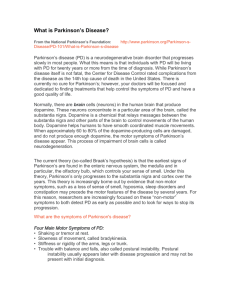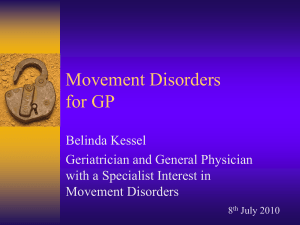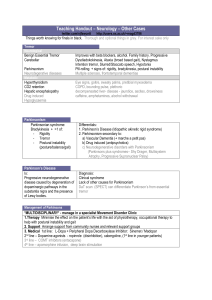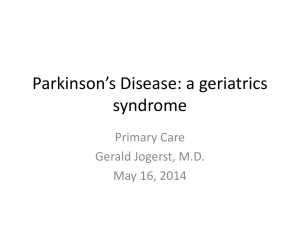Parkinson`s Disease (3)
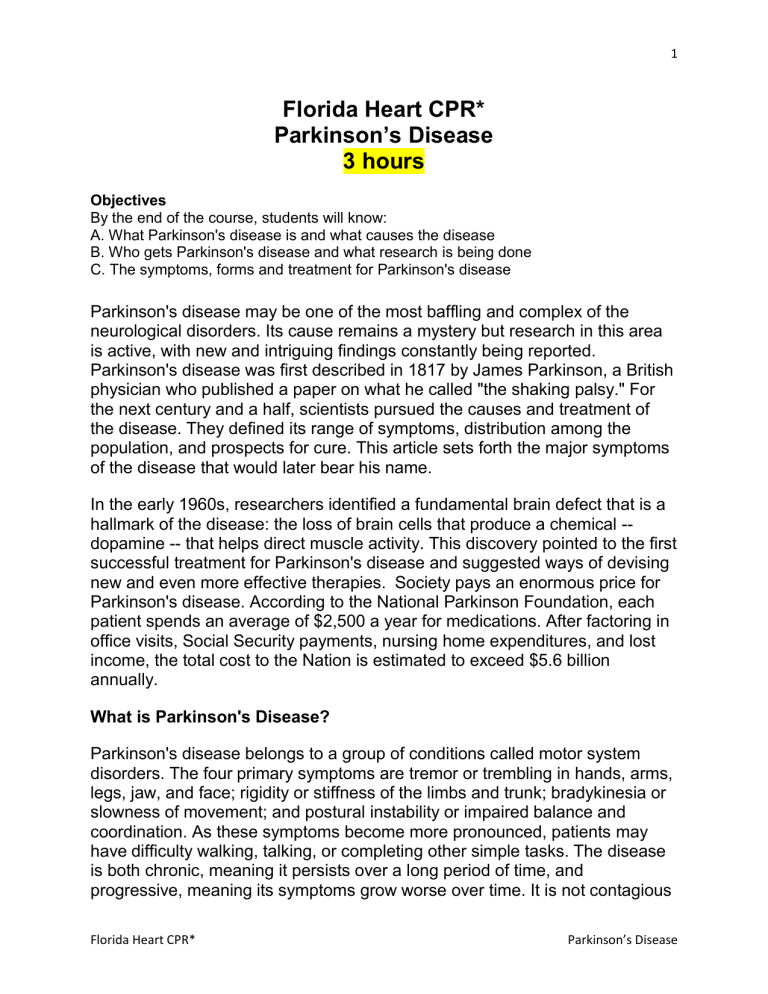
1
Florida Heart CPR*
Parkinson’s Disease
3 hours
Objectives
By the end of the course, students will know:
A. What Parkinson's disease is and what causes the disease
B. Who gets Parkinson's disease and what research is being done
C. The symptoms, forms and treatment for Parkinson's disease
Parkinson's disease may be one of the most baffling and complex of the neurological disorders. Its cause remains a mystery but research in this area is active, with new and intriguing findings constantly being reported.
Parkinson's disease was first described in 1817 by James Parkinson, a British physician who published a paper on what he called "the shaking palsy." For the next century and a half, scientists pursued the causes and treatment of the disease. They defined its range of symptoms, distribution among the population, and prospects for cure. This article sets forth the major symptoms of the disease that would later bear his name.
In the early 1960s, researchers identified a fundamental brain defect that is a hallmark of the disease: the loss of brain cells that produce a chemical -- dopamine -- that helps direct muscle activity. This discovery pointed to the first successful treatment for Parkinson's disease and suggested ways of devising new and even more effective therapies. Society pays an enormous price for
Parkinson's disease. According to the National Parkinson Foundation, each patient spends an average of $2,500 a year for medications. After factoring in office visits, Social Security payments, nursing home expenditures, and lost income, the total cost to the Nation is estimated to exceed $5.6 billion annually.
What is Parkinson's Disease?
Parkinson's disease belongs to a group of conditions called motor system disorders. The four primary symptoms are tremor or trembling in hands, arms, legs, jaw, and face; rigidity or stiffness of the limbs and trunk; bradykinesia or slowness of movement; and postural instability or impaired balance and coordination. As these symptoms become more pronounced, patients may have difficulty walking, talking, or completing other simple tasks.
The disease is both chronic, meaning it persists over a long period of time, and progressive, meaning its symptoms grow worse over time. It is not contagious
Florida Heart CPR* Parkinson’s Disease
nor is it usually inherited -- that is, it does not pass directly from one family member or generation to the next.
Parkinson's disease is the most common form of parkinsonism, the name for a group of disorders with similar features
.These disorders share the four primary symptoms described above, and all are the result of the loss of dopamine-producing brain cells. Parkinson's disease is also called primary parkinsonism or idiopathic Parkinson's disease; idiopathic is a term describing a disorder for which no cause has yet been found. In the other forms of parkinsonism either the cause is known or suspected or the disorder occurs as a secondary effect of another, primary neurological disorder.
2
What Causes the Disease?
Parkinson's disease occurs when certain nerve cells, or neurons, in an area of the brain known as the substantia nigra die or become impaired. Normally, these neurons produce an important brain chemical known as dopamine.
Dopamine is a chemical messenger responsible for transmitting signals between the substantia nigra and the next "relay station" of the brain, the corpus striatum, to produce smooth, purposeful muscle activity. Loss of dopamine causes the nerve cells of the striatum to fire out of control, leaving patients unable to direct or control their movements in a normal manner.
Studies have shown that Parkinson's patients have a loss of 80 percent or more of dopamine-producing cells in the substantia nigra. The cause of this cell death or impairment is not known but significant findings by research scientists continue to yield fascinating new clues to the disease.
One theory holds that free radicals -- unstable and potentially damaging molecules generated by normal chemical reactions in the body -- may contribute to nerve cell death thereby leading to Parkinson's disease. Free radicals are unstable because they lack one electron; in an attempt to replace this missing electron, free radicals react with neighboring molecules
(especially metals such as iron), in a process called oxidation. Oxidation is thought to cause damage to tissues, including neurons. Normally, free radical damage is kept under control by antioxidants, chemicals that protect cells from this damage. Evidence that oxidative mechanisms may cause or contribute to
Parkinson's disease includes the finding that patients with the disease have increased brain levels of iron, especially in the substantia nigra, and decreased levels of ferritin, which serves as a protective mechanism by chelating or forming a ring around the iron, and isolating it.
Some scientists have suggested that Parkinson's disease may occur when either an external or an internal toxin selectively destroys dopaminergic
Florida Heart CPR* Parkinson’s Disease
3 neurons. An environmental risk factor such as exposure to pesticides or a toxin in the food supply is an example of the kind of external trigger that could hypothetically cause Parkinson's disease. The theory is based on the fact that there are a number of toxins, such as 1-methyl-4-phenyl-1,2,3,6,tetrahydropyridine (MPTP) and neuroleptic drugs, known to induce parkinsonian symptoms in humans. So far, however, no research has provided conclusive proof that a toxin is the cause of the disease.
A relatively new theory explores the role of genetic factors in the development of Parkinson's disease. Fifteen to twenty percent of Parkinson's patients have a close relative who has experienced parkinsonian symptoms (such as a tremor). After studies in animals showed that MPTP interferes with the function of mitochondria within nerve cells, investigators became interested in the possibility that impairment in mitochondrial DNA may be the cause of
Parkinson's disease. Mitochondria are essential organelles found in all animal cells that convert the energy in food into fuel for the cells.
Yet another theory proposes that Parkinson's disease occurs when, for unknown reasons, the normal, age-related wearing away of dopamine-producing neurons accelerates in certain individuals.
This theory is supported by the knowledge that loss of antioxidative protective mechanisms is associated with both
Parkinson's disease and increasing age.
Many researchers believe that a combination of these four mechanisms -- oxidative damage, environmental toxins, genetic predisposition, and accelerated aging -- may ultimately be shown to cause the disease.
Who Gets Parkinson's Disease?
About 50,000 Americans are diagnosed with Parkinson's disease each year, with more than half a million Americans affected at any one time. Getting an accurate count of the number of cases may be impossible however, because many people in the early stages of the disease assume their symptoms are the result of normal aging and do not seek help from a physician. Also, diagnosis is sometimes difficult and uncertain because other conditions may produce some of the symptoms of Parkinson's disease. People with
Parkinson's disease may be told by their doctors that they have other disorders or, conversely, people with similar diseases may be initially diagnosed as having Parkinson's disease.
Parkinson's disease strikes men and women in almost equal numbers and it knows no social, economic, or geographic boundaries. Some studies show that African-Americans and Asians are less likely than whites to develop
Parkinson's disease. Scientists have not been able to explain this apparent
Florida Heart CPR* Parkinson’s Disease
4 lower incidence in certain populations. It is reasonable to assume, however, that all people have a similar probability of developing the disease.
Age, however, clearly correlates with the onset of symptoms. Parkinson's disease is a disease of late middle age, usually affecting people over the age of 50.
The average age of onset is 60 years.
However, some physicians have reportedly noticed more cases of "early-onset" Parkinson's disease in the past several years, and some have estimated that five to ten percent of patients are under the age of 40.
What are the Early Symptoms?
Early symptoms of Parkinson's disease are subtle and occur gradually.
Patients may be tired or notice a general malaise. Some may feel a little shaky or have difficulty getting out of a chair. They may notice that they speak too softly or that their handwriting looks cramped and spidery. They may lose track of a word or thought, or they may feel irritable or depressed for no apparent reason. This very early period may last a long time before the more classic and obvious symptoms appear.
Friends or family members may be the first to notice changes. They may see that the person's face lacks expression and animation (known as "masked face") or that the person remains in a certain position for a long time or does not move an arm or leg normally.
Perhaps they see that the person seems stiff, unsteady, and unusually slow.
As the disease progresses, the shaking, or tremor, that affects the majority of
Parkinson's patients may begin to interfere with daily activities. Patients may not be able to hold utensils steady or may find that the shaking makes reading a newspaper difficult. Parkinson's tremor may become worse when the patient is relaxed. A few seconds after the hands are rested on a table, for instance, the shaking is most pronounced. For most patients, tremor is usually the symptom that causes them to seek medical help.
What are the Major Symptoms of the Disease?
Parkinson's disease does not affect everyone the same way. In some people the disease progresses quickly, in others it does not. Although some people become severely disabled, others experience only minor motor disruptions.
Tremor is the major symptom for some patients, while for others tremor is only a minor complaint and different symptoms are more troublesome.
Tremor.
The tremor associated with Parkinson's disease has a characteristic appearance.
Typically, the tremor takes the form of a rhythmic back-and-forth motion of the thumb and forefinger at three beats per second. This is sometimes called "pill rolling." Tremor usually begins in a hand, although
Florida Heart CPR* Parkinson’s Disease
5 sometimes a foot or the jaw is affected first. It is most obvious when the hand is at rest or when a person is under stress. In three out of four patients, the tremor may affect only one part or side of the body, especially during the early stages of the disease. Later it may become more general. Tremor is rarely disabling and it usually disappears during sleep or improves with intentional movement.
Rigidity. Rigidity, or a resistance to movement, affects most parkinsonian patients. A major principle of body movement is that all muscles have an opposing muscle. Movement is possible not just because one muscle becomes more active, but because the opposing muscle relaxes. In
Parkinson's disease, rigidity comes about when, in response to signals from the brain, the delicate balance of opposing muscles is disturbed. The muscles remain constantly tensed and contracted so that the person aches or feels stiff or weak. The rigidity becomes obvious when another person tries to move the patient's arm, which will move only in ratchet-like or short, jerky movements known as "cogwheel" rigidity.
Bradykinesia. Bradykinesia, or the slowing down and loss of spontaneous and automatic movement, is particularly frustrating because it is unpredictable. One moment the patient can move easily. The next moment he or she may need help. This may well be the most disabling and distressing symptom of the disease because the patient cannot rapidly perform routine movements. Activities once performed quickly and easily -- such as washing or dressing -may take several hours.
Postural instability. Postural instability, or impaired balance and coordination, causes patients to develop a forward or backward lean and to fall easily. When bumped from the front or when starting to walk, patients with a backward lean have a tendency to step backwards, which is known as retropulsion. Postural instability can cause patients to have a stooped posture in which the head is bowed and the shoulders are drooped.
As the disease progresses, walking may be affected. Patients may halt in midstride and "freeze" in place, possibly even toppling over. Or patients may walk with a series of quick, small steps as if hurrying forward to keep balance. This is known as festination.
Are There Other Symptoms?
Various other symptoms accompany Parkinson's disease; some are minor, others are more bothersome. Many can be treated with appropriate medication or physical therapy. No one can predict which symptoms will affect an individual patient, and the intensity of the symptoms also varies from
Florida Heart CPR* Parkinson’s Disease
6 person to person. None of these symptoms is fatal, although swallowing problems can cause choking.
Depression. This is a common problem and may appear early in the course of the disease, even before other symptoms are noticed. Depression may not be severe, but it may be intensified by the drugs used to treat other symptoms of Parkinson's disease. Fortunately, depression can be successfully treated with antidepressant medications.
Emotional changes. Some people with Parkinson's disease become fearful and insecure.
Perhaps they fear they cannot cope with new situations. They may not want to travel, go to parties, or socialize with friends. Some lose their motivation and become dependent on family members. Others may become irritable or uncharacteristically pessimistic.
Memory loss and slow thinking may occur, although the ability to reason remains intact. Whether people actually suffer intellectual loss (also known as dementia) from Parkinson's disease is a controversial area still being studied.
Difficulty in swallowing and chewing. Muscles used in swallowing may work less efficiently in later stages of the disease. In these cases, food and saliva may collect in the mouth and back of the throat, which can result in choking or drooling. Medications can often alleviate these problems.
Speech changes. About half of all parkinsonian patients have problems with speech. They may speak too softly or in a monotone, hesitate before speaking, slur or repeat their words, or speak too fast. A speech therapist may be able to help patients reduce some of these problems.
Urinary problems or constipation. In some patients bladder and bowel problems can occur due to the improper functioning of the autonomic nervous system, which is responsible for regulating smooth muscle activity. Some people may become incontinent while others have trouble urinating. In others, constipation may occur because the intestinal tract operates more slowly. Constipation can also be caused by inactivity, eating a poor diet, or drinking too little fluid. It can be a persistent problem and, in rare cases, can be serious enough to require hospitalization.
Patients should not let constipation last for more than several days before taking steps to alleviate it.
Skin problems. In Parkinson's disease, it is common for the skin on the face to become very oily, particularly on the forehead and at the sides of the nose.
The scalp may become oily too, resulting in dandruff. In other cases, the skin can become very dry. These problems are also the result of an improperly functioning autonomic nervous system. Standard treatments for skin problems
Florida Heart CPR* Parkinson’s Disease
help. Excessive sweating, another common symptom, is usually controllable with medications used for Parkinson's disease.
7
Sleep problems. These include difficulty staying asleep at night, restless sleep, nightmares and emotional dreams, and drowsiness during the day. It is unclear if these symptoms are related to the disease or to the medications used to treat Parkinson's disease. Patients should never take over-the-counter sleep aids without consulting their physicians.
What are the Other Forms of Parkinsonism?
Postencephalitic parkinsonism. Just after the first World War, a viral disease, encephalitis lethargica, attacked almost 5 million people throughout the world, and then suddenly disappeared in the 1920s. Known as sleeping sickness in the United States, this disease killed one third of its victims and in many others led to post-encephalitic parkinsonism, a particularly severe form of movement disorder in which some patients developed, often years after the acute phase of the illness, disabling neurological disorders, including various forms of catatonia. (In 1973, neurologist Oliver Sacks published Awakenings, an account of his work in the late 1960's with surviving post-encephalitic patients in a New York hospital. Using the then-experimental drug levodopa,
Dr. Sacks was able to temporarily "awaken" these patients from their statuelike state. A film by the same name was released in 1990.) In rare cases, other viral infections, including western equine encephalomyelitis, eastern equine encephalomyelitis, and Japanese B encephalitis, can leave patients with parkinsonian symptoms.
Drug-induced parkinsonism.
A reversible form of parkinsonism sometimes results from use of certain drugs -- chlorpromazine and haloperidol, for example -- prescribed for patients with psychiatric disorders. Some drugs used for stomach disorders (metoclopramide) and high blood pressure
(reserpine) may also produce parkinsonian symptoms. Stopping the medication or lowering the dosage causes the symptoms to abate.
Striatonigral degeneration. In this form of parkinsonism, the substantia nigra is only mildly affected, while other brain areas show more severe damage than occurs in patients with primary Parkinson's disease. People with this type of parkinsonism tend to show more rigidity and the disease progresses more rapidly.
Arteriosclerotic parkinsonism. Sometimes known as pseudoparkinsonism, arteriosclerotic parkinsonism involves damage to brain vessels due to multiple
Florida Heart CPR* Parkinson’s Disease
small strokes. Tremor is rare in this type of parkinsonism, while dementia -- the loss of mental skills and abilities -- is common. Antiparkinsonian drugs are of little help to patients with this form of parkinsonism.
8
Toxin-induced parkinsonism. Some toxins -- such as manganese dust, carbon disulfide, and carbon monoxide -- can also cause parkinsonism. A chemical known as MPTP (1-methyl-4-phenyl-1,2,5,6-tetrahydropyridine) causes a permanent form of parkinsonism that closely resembles Parkinson's disease. Investigators discovered this reaction in the 1980s when heroin addicts in California who had taken an illicit street drug contaminated with
MPTP began to develop severe parkinsonism.
This discovery, which demonstrated that a toxic substance could damage the brain and produce parkinsonian symptoms, caused a dramatic breakthrough in Parkinson's research: for the first time scientists were able to simulate Parkinson's disease in animals and conduct studies to increase understanding of the disease.
Parkinsonism-dementia complex of Guam. This form occurs among the
Chamorro populations of Guam and the Mariana Islands and may be accompanied by a disease resembling amyotrophic lateral sclerosis (Lou
Gehrig's disease). The course of the disease is rapid, with death typically occurring within 5 years. Some investigators suspect an environmental cause, perhaps the use of flour from the highly toxic seed of the cycad plant.
This flour was a dietary staple for many years when rice and other food supplies were unavailable in this region, particularly during World War II. Other studies, however, refute this link.
Parkinsonism accompanying other conditions. Parkinsonian symptoms may also appear in patients with other, clearly distinct neurological disorders such as Shy-Drager syndrome (sometimes called multiple system atrophy), progressive supranuclear palsy, Wilson's disease, Huntington's disease,
Hallervorden-Spatz syndrome, Alzheimer's disease, Creutzfeldt-Jakob disease, olivopontocerebellar atrophy, and post-traumatic encephalopathy.
How do Doctors Diagnose Parkinson's Disease?
Even for an experienced neurologist, making an accurate diagnosis in the early stages of Parkinson's disease can be difficult. There are, as yet, no sophisticated blood or laboratory tests available to diagnose the disease. The physician may need to observe the patient for some time until it is apparent that the tremor is consistently present and is joined by one or more of the other classic symptoms. Since other forms of parkinsonism have similar
Florida Heart CPR* Parkinson’s Disease
features but require different treatments, making a precise diagnosis as soon as possible is essential for starting a patient on proper medication.
9
How is the Disease Treated?
At present, there is no cure for Parkinson's disease. But a variety of medications provide dramatic relief from the symptoms.
When recommending a course of treatment, the physician determines how much the symptoms disrupt the patient's life and then tailors therapy to the person's particular condition. Since no two patients will react the same way to a given drug, it may take time and patience to get the dose just right. Even then, symptoms may not be completely alleviated. In the early stages of Parkinson's disease, physicians often begin treatment with one or a combination of the less powerful drugs -such as the anticholinergics or amantadine, saving the most powerful treatment, specifically levodopa, for the time when patients need it most.
Levodopa . Without doubt, the gold standard of present therapy is the drug levodopa (also called L-dopa). LDopa (from the full name L-3,4dihydroxyphenylalanine) is a simple chemical found naturally in plants and animals. Levodopa is the generic name used for this chemical when it is formulated for drug use in patients. Nerve cells can use levodopa to make dopamine and replenish the brain's dwindling supply. Dopamine itself cannot be given because it doesn't cross the blood-brain barrier, the elaborate meshwork of fine blood vessels and cells that filters blood reaching the brain.
Usually, patients are given levodopa combined with carbidopa. When added to levodopa, carbidopa delays the conversion of levodopa into dopamine until it reaches the brain, preventing or diminishing some of the side effects that often accompany levodopa therapy.
Carbidopa also reduces the amount of levodopa needed.
Levodopa's success in treating the major symptoms of Parkinson's disease is a triumph of modern medicine. First introduced in the 1960s, it delays the onset of debilitating symptoms and allows the majority of parkinsonian patients -- who would otherwise be very disabled -- to extend the period of time in which they can lead relatively normal, productive lives.
Although levodopa helps at least three-quarters of parkinsonian cases, not all symptoms respond equally to the drug. Bradykinesia and rigidity respond best, while tremor may be only marginally reduced. Problems with balance and other symptoms may not be alleviated at all.
People who have taken other medications before starting levodopa therapy may have to cut back or eliminate these drugs in order to feel the full benefit of levodopa. Once levodopa therapy starts people often
Florida Heart CPR* Parkinson’s Disease
10 respond dramatically, but they may need to increase the dose gradually for maximum benefit.
Because a high-protein diet can interfere with the absorption of levodopa, some physicians recommend that patients taking the drug restrict protein consumption to the evening meal.
Levodopa is so effective that some people may forget they have Parkinson's disease. But levodopa is not a cure. Although it can diminish the symptoms, it does not replace lost nerve cells and it does not stop the progression of the disease.
Side Effects of Levodopa . Although beneficial for thousands of patients, levodopa is not without its limitations and side effects.
The most common side effects are nausea, vomiting, low blood pressure, involuntary movements, and restlessness. In rare cases patients may become confused. The nausea and vomiting caused by levodopa are greatly reduced by the combination of levodopa and carbidopa which enhances the effectiveness of a lower dose. A slow-release formulation of this product, which gives patients a longer lasting effect, is also available.
Dyskinesias, or involuntary movements such as twitching, nodding, and jerking, most commonly develop in people who are taking large doses of levodopa over an extended period. These movements may be either mild or severe and either very rapid or very slow.
The only effective way to control these drug-induced movements is to lower the dose of levodopa or to use drugs that block dopamine, but these remedies usually cause the disease symptoms to reappear. Doctors and patients must work together closely to find a tolerable balance between the drug's benefits and side effects.
Other more troubling and distressing problems may occur with long-term levodopa use. Patients may begin to notice more pronounced symptoms before their first dose of medication in the morning, and they can feel when each dose begins to wear off (muscle spasms are a common effect).
Symptoms gradually begin to return. The period of effectiveness from each dose may begin to shorten, called the wearing-off effect. Another potential problem is referred to as the on-off effect -sudden, unpredictable changes in movement, from normal to parkinsonian movement and back again, possibly occurring several times during the day. These effects probably indicate that the patient's response to the drug is changing or that the disease is progressing.
One approach to alleviating these side effects is to take levodopa more often and in smaller amounts.
Sometimes, physicians instruct patients to stop levodopa for several days in an effort to improve the response to the drug and to manage the complications of long-term levodopa therapy. This controversial technique is known as a
"drug holiday." Because of the possibility of serious complications, drug holidays should be attempted only under a physician's direct supervision,
Florida Heart CPR* Parkinson’s Disease
11 preferably in a hospital. Parkinson's disease patients should never stop taking levodopa without their physician's knowledge or consent because of the potentially serious side effects of rapidly withdrawing the drug.
Are There Other Medications Available for Managing Disease
Symptoms?
Levodopa is not a perfect drug. Fortunately, physicians have other treatment choices for particular symptoms or stages of the disease. Other therapies include the following: Bromocriptine and pergolide. These two drugs mimic the role of dopamine in the brain, causing the neurons to react as they would to dopamine. They can be given alone or with levodopa and may be used in the early stages of the disease or started later to lengthen the duration of response to levodopa in patients experiencing wearing off or on-off effects.
They are generally less effective than levodopa in controlling rigidity and bradykinesia. Side effects may include paranoia, hallucinations, confusion, dyskinesias, nightmares, nausea, and vomiting.
Selegiline. Also known as deprenyl, selegiline has become a commonly used drug for Parkinson's disease. Recent studies supported by the NINDS have shown that the drug delays the need for levodopa therapy by up to a year or more. When selegiline is given with levodopa, it appears to enhance and prolong the response to levodopa and thus may reduce wearing-off fluctuations. In studies with animals, selegiline has been shown to protect the dopamine-producing neurons from the toxic effects of MPTP. Selegiline inhibits the activity of the enzyme monoamine oxidase B (MAO-B), the enzyme that metabolizes dopamine in the brain, delaying the breakdown of naturally occurring dopamine and of dopamine formed from levodopa.
Dopamine then accumulates in the surviving nerve cells. Some physicians, but not all, favor starting all parkinsonian patients on selegiline because of its possible protective effect. Selegiline is an easy drug to take, although side effects may include nausea, orthostatic hypotension, or insomnia (when taken late in the day). Also, toxic reactions have occurred in some patients who took selegiline with fluoxetine (an antidepressant) and meperidine (used as a sedative and an analgesic).
Research scientists are still trying to answer questions about selegiline use: How long does the drug remain effective?
Does long-term use have any adverse effects? Evaluation of the long-term effects will help determine its value for all stages of the disease.
Anticholinergics. These drugs were the main treatment for Parkinson's disease until the introduction of levodopa. Their benefit is limited, but they may help control tremor and rigidity. They are particularly helpful in reducing drug-
Florida Heart CPR* Parkinson’s Disease
12 induced parkinsonism. Anticholinergics appear to act by blocking the action of another brain chemical, acetylcholine, whose effects become more pronounced when dopamine levels drop. Only about half the patients who receive anticholinergics respond, usually for a brief period and with only a 30 percent improvement. Although not as effective as levodopa or bromocriptine, anticholinergics may have a therapeutic effect at any stage of the disease when taken with either of these drugs.
Common side effects include dry mouth, constipation, urinary retention, hallucinations, memory loss, blurred vision, changes in mental activity, and confusion.
Amantadine. An antiviral drug, amantadine, helps reduce symptoms of Parkinson's disease. It is often used alone in the early stages of the disease or with an anticholinergic drug or levodopa. After several months amantadine's effectiveness wears off in a third to a half of the patients taking it, although effectiveness may return after a brief withdrawal from the drug.
Amantadine has several side effects, including mottled skin, edema, confusion, blurred vision, and depression.
Is Surgery Ever Used to Treat Parkinson's Disease?
Treating Parkinson's disease with surgery was once a common practice. But after the discovery of levodopa, surgery was restricted to only a few cases.
One of the procedures used, called cryothalamotomy, requires the surgical insertion of a super cooled metal tip of a probe into the thalamus (a "relay station" deep in the brain) to destroy the brain area that produces tremors.
This and related procedures are coming back into favor for patients who have severe tremor or have the disease only on one side of the body. Investigators have also revived interest in a surgical procedure called pallidotomy in which a portion of the brain called the globus pallidus is lesioned. Some studies indicate that pallidotomy may improve symptoms of tremor, rigidity, and bradykinesia, possibly by interrupting the neural pathway between the globus pallidus and the striatum or thalamus. Further research on the value of surgically destroying these brain areas is currently being conducted.
Can Diet or Exercise Programs Help Relieve Symptoms?
Diet.
Eating a well-balanced, nutritious diet can be beneficial for anybody. But for preventing or curing Parkinson's disease, there does not seem to be any specific vitamin, mineral, or other nutrient that has any therapeutic value. A high protein diet, however, may limit levodopa's effectiveness.
Despite some early optimism, recent studies have shown that tocopherol (a form of vitamin
E) does not delay Parkinson's disease. This conclusion came from a carefully conducted study supported by the NINDS called DATATOP (Deprenyl and
Tocopherol Antioxidative Therapy for Parkinson's Disease) that examined,
Florida Heart CPR* Parkinson’s Disease
13 over 5 years, the effects of both deprenyl and vitamin E on early Parkinson's disease. While deprenyl was found to slow the early symptomatic progression of the disease and delay the need for levodopa, there was no evidence of therapeutic benefit from vitamin E.
Exercise.
Because movements are affected in Parkinson's disease, exercising may help people improve their mobility. Some doctors prescribe physical therapy or muscle-strengthening exercises to tone muscles and to put underused and rigid muscles through a full range of motion. Exercises will not stop disease progression, but they may improve body strength so that the person is less disabled.
Exercises also improve balance, helping people overcome gait problems, and can strengthen certain muscles so that people can speak and swallow better. Exercises can also improve the emotional wellbeing of parkinsonian patients by giving them a feeling of accomplishment.
Although structured exercise programs help many patients, more general physical activity, such as walking, gardening, swimming, calisthenics, and using exercise machines, is also beneficial.
What are the Benefits of Support Groups?
One of the most demoralizing aspects of the disease is how completely the patient's world changes.
The most basic daily routines may be affected -- from socializing with friends and enjoying normal and congenial relationships with family members to earning a living and taking care of a home. Faced with a very different life, people need encouragement to remain as active and involved as possible.
That's when support groups can be of particular value to parkinsonian patients, their families, and their caregivers.
Can Scientists Predict or Prevent Parkinson's Disease?
As yet, there is no way to predict or prevent the disease. However, researchers are now looking for a biomarker -- a biochemical abnormality that all patients with Parkinson's disease might share -that could be picked up by screening techniques or by a simple chemical test given to people who do not have any parkinsonian symptoms.
Positron emission tomography (PET) scanning may lead to important advances in our knowledge about Parkinson's disease. PET scans of the brain produce pictures of chemical changes as they occur in the living brain. Using PET, research scientists can study the brain's dopamine receptors (the sites on nerve cells that bind with dopamine) to determine if the loss of dopamine activity follows or precedes degeneration of the neurons that make this chemical. This information could help scientists
Florida Heart CPR* Parkinson’s Disease
better understand the disease process and may potentially lead to improved treatments.
14
What Research is Being Done?
In the last decade research has laid the groundwork for many of today's promising new clinical trials, technologies, and drug treatments. Scientists, physicians, and patients hope that today's progress means tomorrow's cure and prevention.
Parkinson's disease research focuses on many areas. Some investigators are studying the functions and anatomy of the motor system and how it regulates movement and relates to major command centers in the brain. Scientists looking for the cause of Parkinson's disease will continue to search for possible environmental factors, such as toxins that may trigger the disorder, and to study genetic factors to determine if one or many defective genes play a role. Although Parkinson's disease is not directly inherited, it is possible that some people are genetically more or less susceptible to developing it. Other scientists are working to develop new protective drugs that can delay, prevent, or reverse the disease.
Since the accidental discovery that MPTP causes parkinsonian symptoms in humans, scientists have found that by injecting MPTP into laboratory animals, they can reproduce the brain lesions that cause these symptoms. This allows them to study the mechanisms of the disease and helps in the development of new treatments. For instance, it was from animal studies that researchers discovered that the drug selegiline can prevent the toxic effects of MPTP. This discovery helped spark interest in studying selegiline as a preventive treatment in humans.
Scientists are also investigating the role of mitochondria, structures in cells that provide the energy for cellular activity, in Parkinson's disease. Because MPTP interferes with the function of mitochondria within nerve cells, some scientists suspect that similar abnormalities may be involved in Parkinson's disease.
Today, an array of promising research involves studying brain areas other than the substantia nigra that may be involved in the disease. One group of
NINDS-supported scientists is studying the consequences of dopamine cell degeneration in the basal ganglia -- brain structures located deep in the forebrain that help control voluntary movement. In laboratory animals, MPTPinduced reduction of dopamine results in overactivity of nerve cells in a region of the brain called the subthalamic nucleus, producing tremors and rigidity and suggesting that these symptoms may be related to excessive activity in this region. Destroying the subthalamic nucleus results in a reversal of parkinsonian symptoms in the animal models.
Scientists supported by the
Florida Heart CPR* Parkinson’s Disease
15
NINDS are also looking for clues to the cause of Parkinson's disease by studying malfunctions in the structures called "dopamine transporters" that carry dopamine in and out of the synapse, or narrow gap between nerve cells.
For example, one research group recently found an age-related decrease in the concentration of dopamine transporters in healthy human nerve cells taken from areas of the brain damaged by Parkinson's. This decline in transporter concentration means that any further threat to the remaining dopamine transporters could result in Parkinson's disease.
The search for more effective medications for Parkinson's disease is likely to be aided by the recent isolation of at least five individual brain receptors for dopamine. New information about the unique effects of each individual dopamine receptor on different brain areas has led to new treatment theories and clinical trials.
Scientists are also studying new methods for delivering dopamine to critical areas in the brain.
NINDS-supported investigators, using an animal model of the disease, implanted tiny dopamine-containing particles into brain regions affected by the disease. They found that such implants can partially ameliorate the movement problems exhibited by these animals. The results suggest that similar techniques may one day work for people with
Parkinson's disease.
A recent study revealed that when the experimental drug Ro 40-7592 is added to the standard drug treatment for Parkinson's disease, levodopa-carbidopa, symptom relief is prolonged by more than 60 percent. Although levodopacarbidopa restores normal movement early in the disease's course, the treatment loses effectiveness as the disease progresses (wearing-off effect).
NINDS scientists found, however, that patients treated with both levodopacarbidopa and Ro 40-7592 experienced longer periods of improved movement. This promising new drug that blocks the breakdown of dopamine and levodopa would allow patients to take fewer doses and smaller amounts of levodopa-carbidopa and to decrease the problems of the wearing-off effect.
At the present time, Ro 40-7592 is still in the experimental stage. Scientists are continuing to study the drug to learn whether it can be given in multiple daily doses to provide even further improvement.
Also under investigation are additional controlled-release formulas of Parkinson's disease drugs and implantable pumps that give a continuous supply of levodopa to help patients who have problems with fluctuating levels of response.
Another promising treatment method involves implanting capsules containing dopamine-producing cells into the brain. The capsules are surrounded by a biologically inert membrane that lets the drug pass through at a timed rate.
Neural grafting, or transplantation of nerve cells, is an experimental technique
Florida Heart CPR* Parkinson’s Disease
16 proposed for treating the disease. NINDS-supported investigators have shown in animal models that implanting fetal brain tissue from the substantia nigra into a parkinsonian brain causes damaged nerve cells to regenerate.
In
January 1994, the NINDS awarded a research grant to a group of scientists from three institutions to conduct a controlled clinical trial of fetal tissue implants in humans. The treatment attempts to replace the lost or damaged dopamine-producing neurons with healthy, fetal neurons, and thereby improve movement and response to medications. A new and promising approach may be the use of genetically engineered cells -- that is, cells such as modified skin cells that do not come from the nervous system but are grown in tissue culture
-- that could have the same beneficial effects. Skin cells would be much easier to harvest and patients could serve as their own donors.
What Can I Do to Help?
The NINDS and the National Institute of Mental Health jointly support two national brain specimen banks. These banks supply research scientists around the world with nervous system tissue from patients with neurological and psychiatric disorders. They need tissue from patients with Parkinson's disease so that scientists can study and understand the disorder. Those who may be interested in donating should write to: Dr. Wallace W. Tourtellotte,
Director National Neurological Research Specimen Bank VAMC-West Los
Angeles 11301 Wilshire Boulevard Los Angeles, CA 90073 Dr. Edward D.
Bird, Director Brain Tissue Resource Center McLean Hospital 115 Mill Street
Belmont, MA 02178 National Disease Research Interchange (NDRI) 1880 JFK
Boulevard 6th Floor Philadelphia, PA 19103 University of Miami Brain
Endowment Bank Department of Neurology (D4-5) 1501 NW 9th Avenue
Miami, FL 33101
Resources & Information provided by the NIH & National Heart, Lung, and
Blood Institute
Florida Heart CPR* Parkinson’s Disease
17
Florida Heart CPR*
Parkinson’s Disease Assessment
1. In the early 1960s, researchers identified a fundamental brain defect that is a hallmark of Parkinson’s disease: the loss of brain cells that produce a chemical --
_____ -- that helps direct muscle activity. a.
Adrenaline b.
Norepinephrine c.
Dopamine d.
Serotonin
2. Bradykinesia means a. Slowness of movement b. Lack of movement c. Muscle spasms d. Painful movement
3.
Parkinson’s disease is a. Chronic and stable b. Chronic and progressive c. Acute and progressive d. Acute and self-limiting
4.
Parkinson’s disease is caused by a. Genetics b. Environmental factors c. Infection d.
The causes of Parkinson’s disease are unknown
5. The average age of onset of Parkinson’s disease is a. 40 years b. 50 years c. 60 years d. 70 years
6. Early symptoms of Parkinson's disease are a.
Subtle but progress very rapidly b.
Obvious but occur gradually c.
Subtle and occur slowly d.
Obvious and progress very rapidly
7. Tremor is _____ disabling and it usually disappears during sleep or improves with intentional movement. a. Rarely b. Sometimes
Florida Heart CPR* Parkinson’s Disease
c. Often d. Almost always
8. ______, or impaired balance and coordination, causes patients to develop a forward or backward lean and to fall easily. a.
Postural stiffness b.
Postural instability c.
Bradykinesia d.
Akinesia
9. Individuals with Parkinson’s disease may also experience a. Speech problems b. Issues with bowel and bladder control c. Disturbances in sleep patterns d. All of the above
10. The standard treatment for Parkinson’s is a. Levadopa b. Dopamine c. Morphine d. Muscle relaxants
18
Florida Heart CPR* Parkinson’s Disease


